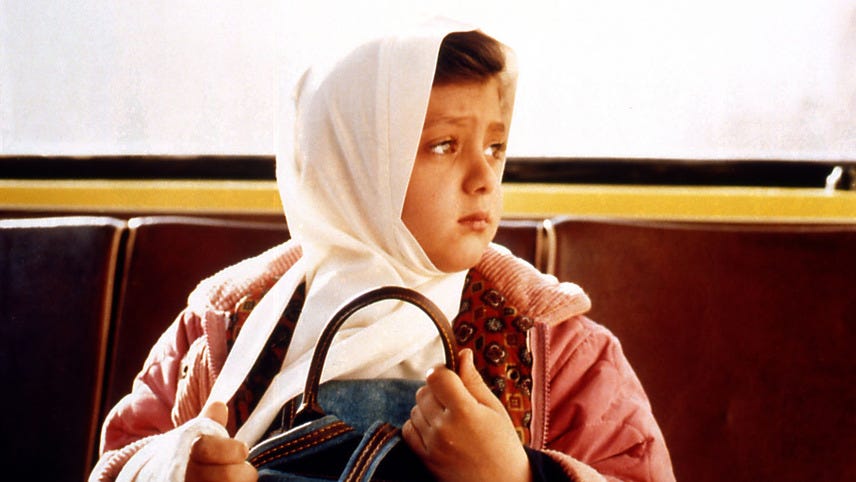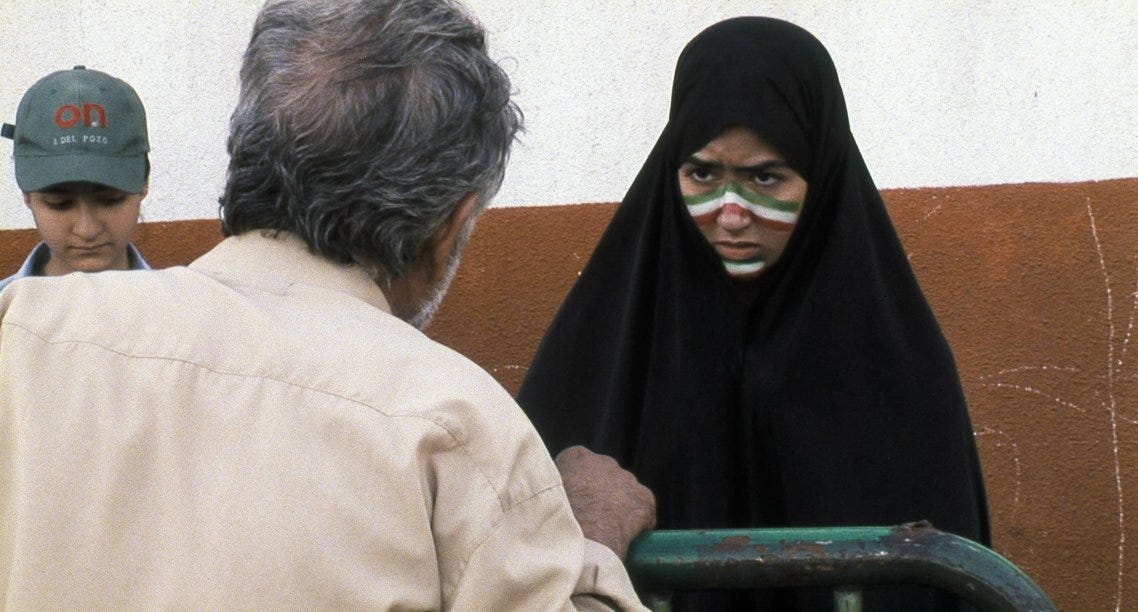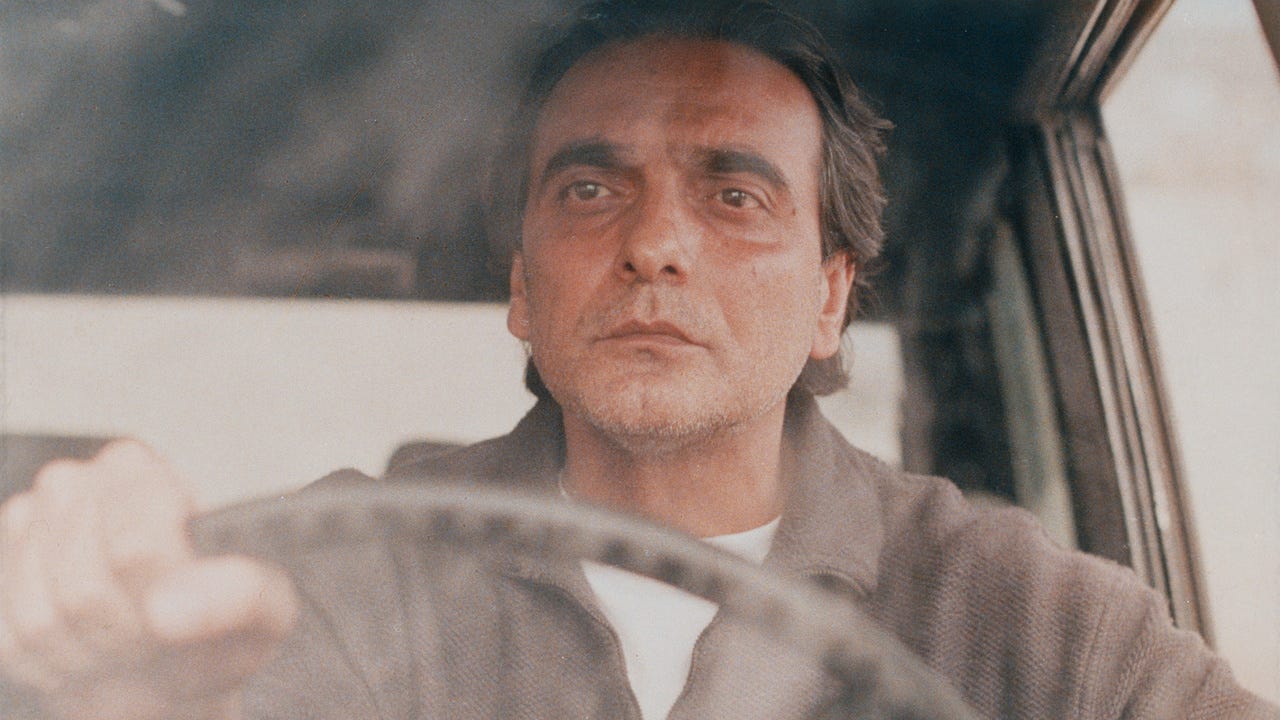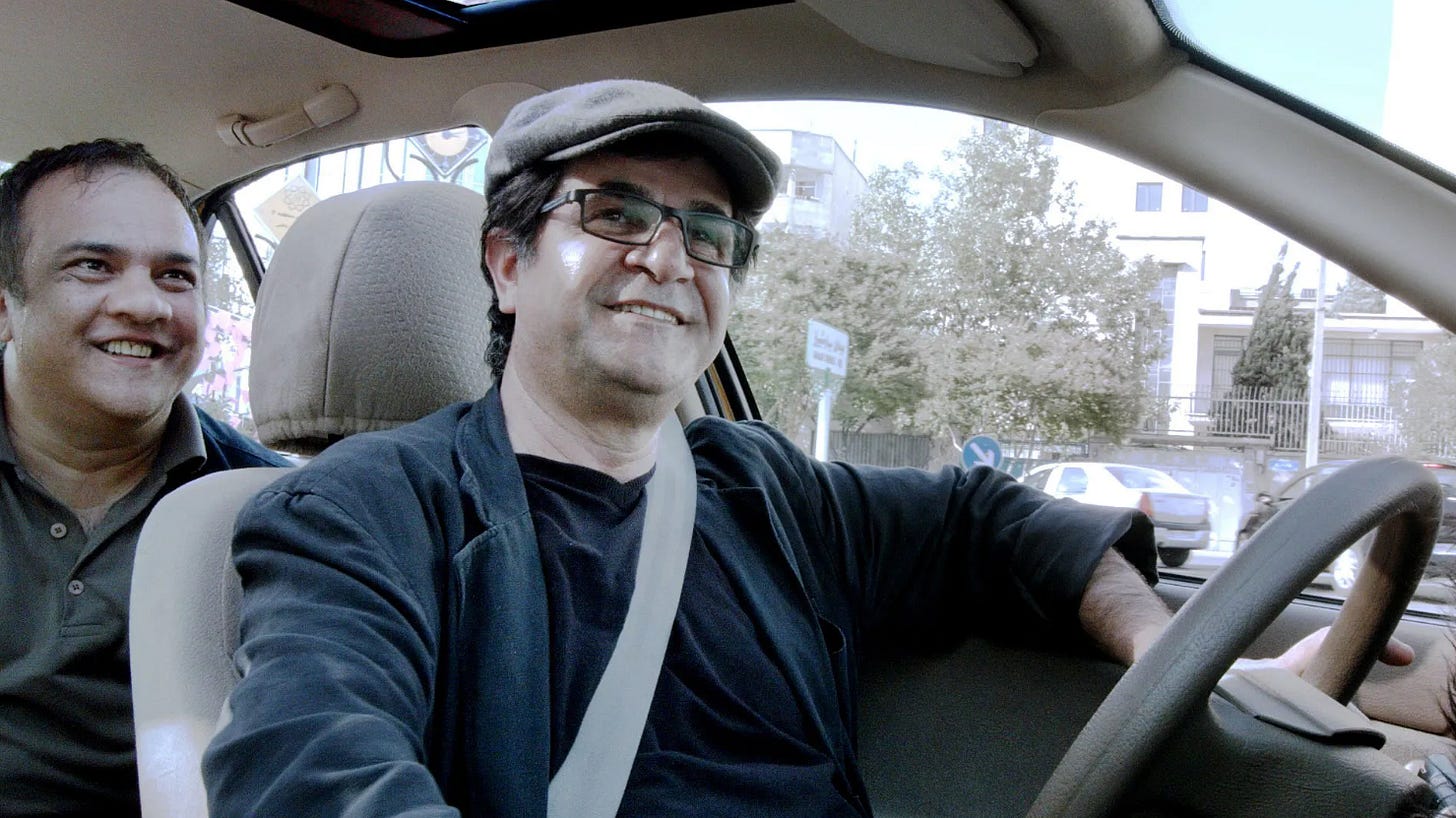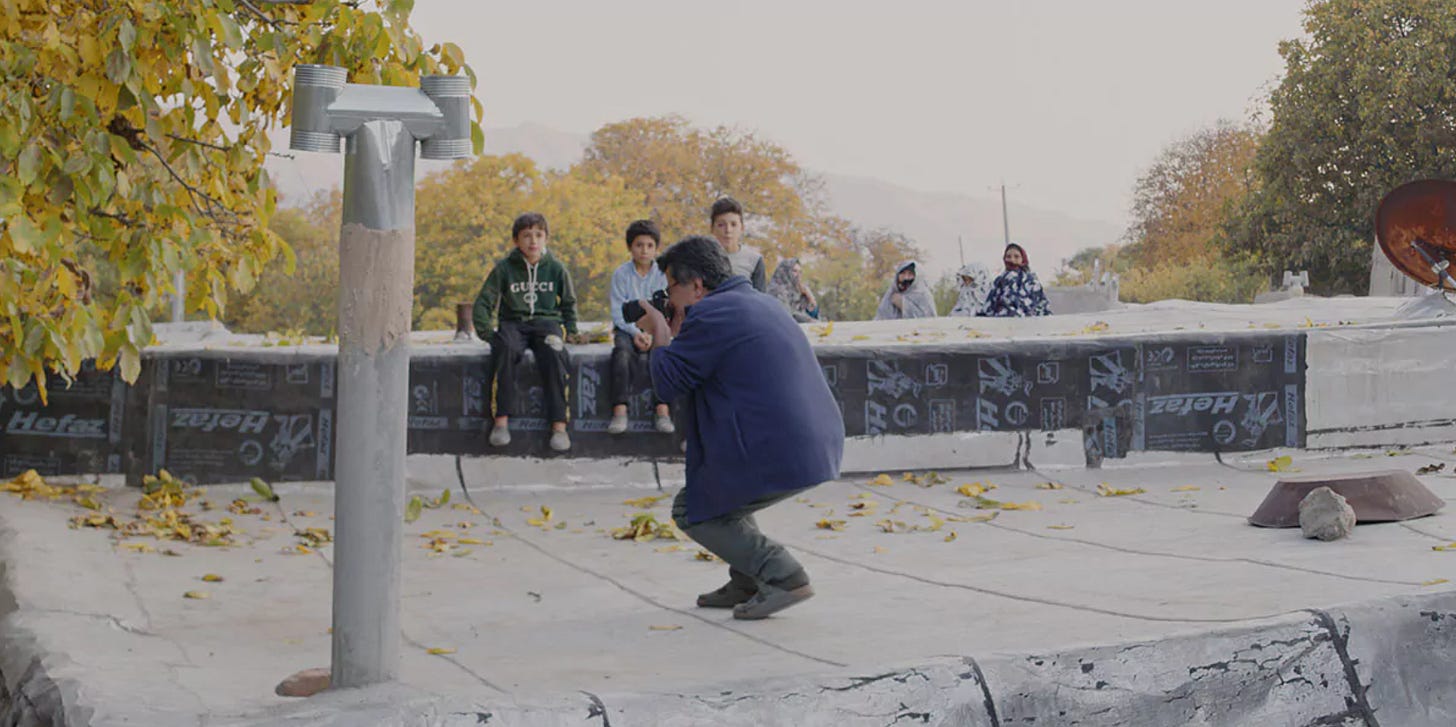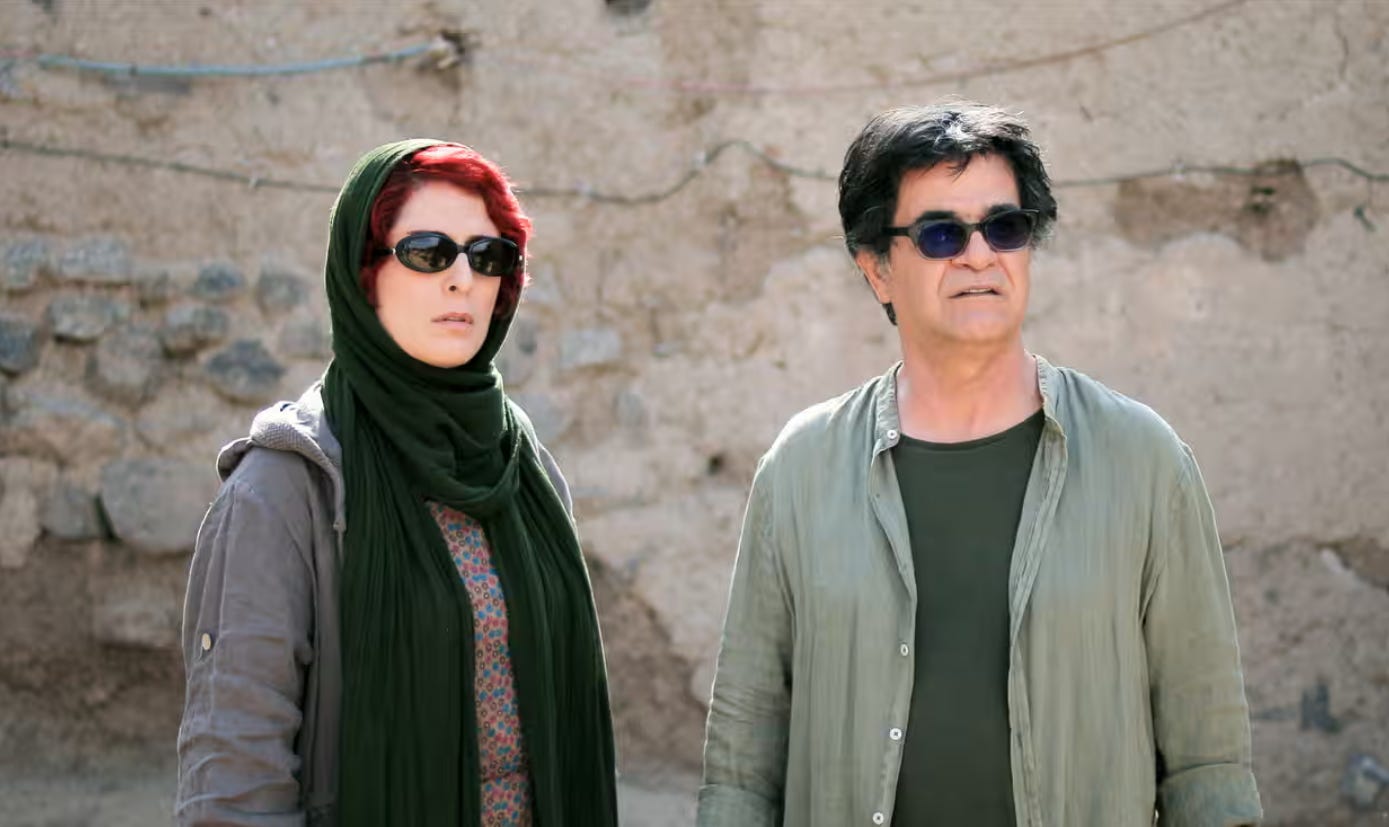Before I start writing about all the other stuff I saw at the Sydney Film Festival, I have to point out that watching all of Jafar Panahi’s films in one fell swoop—except for Crimson Gold, which I’d seen before—was one of the great cinematic experiences of my life.
It wasn’t that Panahi was present in Sydney, though that was obviously a nice touch. (After Israel and Iran went to war, he didn’t rock up to screenings anymore. He did run a masterclass on the festival’s last day, but he was mostly in his hotel room, trying to contact people back home.) I had in any case met him before, in Brisbane in 2003, when Crimson Gold played there. He also doesn’t speak a lick of English so it’s not as though we would have been able to talk about much.
But to see, over two weeks, the entirety of his oeuvre—and to witness just how much it changes after he was thrown in prison and banned from filmmaking—was a wonderful experience. I don’t think you could say with any great honesty that he’s not one of the most important filmmakers working today. There may be better, but I do not know many who are more important, except, for those we’ve never heard from, because they, too, have been prevented from making movies.
His filmography can be broken into two distinct phases (though I suspect it’s currently entering a third). There are the films he made when he was allowed to make films and there are the films he made after he was not. The two phases share a lot in common—particularly their meta, extra-cinematic qualities, which are on display as early as Mirror, when, halfway through the film, the child actor looks into the camera and Panahi yells cut—but the vibe of them changes, becoming angrier over time. His first two films, The White Balloon and Mirror, are films about children, which take an innocent-seeming, feel-good approach that effectively allows him to explore Iranian society—especially its feelings about women, and to a slightly lesser extent about money—on the sly without getting him into too much trouble. By the time he gets to his third, The Circle, he’s no longer pulling punches. That film follows various women who have recently escaped or been released from prison, where all of them have been placed on morality charges, until we get thrown the clink ourselves, only to realise, with one final, devastating pan around the room, that everyone who’s story we’ve been following has been thrown back in as well.
Crimson Gold blew my mind when I saw it in 2003. I should have seen it again this year, but there was a clash. It, too, is a very political film, this time about class and mental illness, with an incredible central performance from Hossain Emadeddin as a downtrodden, schizophrenic pizza delivery man. (Panahi, who regularly works with non-professional actors, discusses one of Emadeddin’s more affecting scenes at length in This is Not a Film.) After that, he’s off to the races. His next film, Offside, is about a group of girls who dress up as boys in order to get into Iran’s 2005 World Cup qualifying match against Bahrain. I particularly like the girl who gets in by dressing in an officer’s uniform and who only gets caught because she dares to watch the game from the officers’ box. I also have a soft spot for the one who, when her friend’s father rocks up, timidly puts her hijab back on before daring to speak to him. The Iranian flag is still painted on her cheeks.
Offside is, along with Crimson Gold, my favorite of Panahi’s early films, in part because it’s his first and only straight-up comedy, and in part because it’s a documentary at the same time. The final sequence, which was shot in the lead up to and aftermath of the match in question, is one for the ages. It’s also the last time Panahi strikes a note of unambiguous hope.
After he publicly supported the Green Movement in 2009, he was told that he couldn’t make films for twenty years, at which point he started making films in secret. He was always interesting, but this is where, to paraphrase Hunter S. Thompson, the going got weird and the weird turned pro. It’s where the lessons Panahi learned from Abbas Kiarostami began to come in handy.
Kiarostami was Iran’s most important filmmaker from the late 1980s to at least 1997, when his masterpiece (or at least one of them), Taste of Cherry, became the first Iranian film to win the Palme d’Or at Cannes. (He died in 2016, by which point Panahi had arguably eclipsed him, though I really do mean arguably.) While Kiarostami was never officially banned from making movies, most of his stuff was never shown in Iran and he faced considerable restrictions. Already an inventive filmmaker—I would urge you to see his 1990 movie Close-Up—he increasingly found himself experimenting with ways to make films without official sanction, especially with consumer-level digital technology. In 2002, he made Ten, which proved that a filmmaker could make a film confined entirely to a car, on video, with next to no money, and still have it be really good. (Panahi would learn this lesson well.) The following year, he made Five, which was basically an experimental film in the vein of the great James Benning, albeit it with some very characteristic winks to the audience. (My own film, Writing: An Homage to James and Abbas, was self-consciously based on Five and Benning’s 13 Lakes.)
It is worth pointing out that Panahi worked as an assistant director on Kiarostami’s Through the Olive Trees. Kiarostami liked the kid and wrote both The White Balloon and Crimson Gold. Panahi was an acolyte, then a colleague, then an interlocutor. Mirror, in particular, shares a considerable amount of genetic material with Close-Up. But the real cinematic conversation between the two—the point at which Panahi really starts talking aloud to Kiarostami—begins after the ban. Ten is probably more relevant to this part of Panahi’s career, and we’ll come to Taxi and 3 Faces in a moment, though there are glimpses of Five in Closed Curtain as well.
Panahi’s first clandestine film, This is Not a Film, is great. It’s also clearly something of a first attempt. The conceit of Panahi reading and, in some cases, acting out a script he was not permitted to film is a good one, and his need to be seen to not be directing is never anything less than amusing. (His co-director, Mojtaba Mirtahmasb, was later arrested for his involvement in a BBC Persian documentary about Ayatollah Khamenei.) The final sequence of This is Not a Film, when a kid collecting the bins in Panahi’s building starts telling a story about the night Panahi was arrested but never quite gets around to the end of it, adds a nice, indeterminate grace note. The film, which was shot on a prosumer digital camera and a phone, purports to cover a single day—on which Panahi is to learn whether or not he’s going to prison—but was in fact shot over the course of two weeks. (Try guessing which parts are real and which aren’t.) It also introduces “Panahi” as a character. We are going to spend a lot of time with him.
Taxi, which was the third film Panahi made under the ban (we’ll come back to the second), is very good and very funny, similar to Ten but weirder. In it, Panahi has taken to driving a taxi, on the grounds that he can’t make films anymore. He of course is not a taxi driver, and we are of course watching a film he has made, but rather than linger on this as though it is some great paradox, he has one of his passengers point this out as soon as he gets in the car. The passenger notes the camera on the dash and asks whether the passengers who have just alighted were actors. The film is Ten with a greater sense of humour, but it’s also Ten with real spite for the government. The final scene has Panahi tracking down two elderly passengers from earlier in the day. One of them has left a purse in the car. He gets out and walks away, but the cameras keep rolling. At which point two intelligence officers, who have apparently been trailing him, break in and put an end to the proceedings. That this, too, is staged is obvious. It doesn’t matter, though. The tip of the point he’s making is sharp.
I thought Taxi was one of Panahi’s best films when I saw it, but the post-ban films that have lingered with me most are Closed Curtain and No Bears. They are to some extent the strangest—and Closed Curtain easily the darkest—of the lot.
Closed Curtain reminded me of early Polanski—Cul-de-sac, in particular—though a more contemporary reference would be Haneke’s Funny Games, or basically any bottle episode of television you’ve ever seen. A writer has come to a villa on the Caspian to write, travelling with his dog. He puts blackout curtains up. Two strangers arrive, in the dead of night, pretty much on the lam. The boy eventually leaves. The girl stays. The writer is perturbed and doesn’t want her there. She is, the boy has told the writer, prone to making suicide attempts. But the writer’s main concern is that he doesn’t want anyone drawing police attention to himself. It is has been decreed that dogs are un-Islamic.
Halfway through the film, the girl, Melika, runs around pulling down the curtains. She also pulls sheets off the walls, which reveals large, framed movie posters that have, until now, been hidden from view. Anyone who has seen Mirror will immediately recognise them as Panahi’s—Mirror’s is the most prominent—except that they are all flipped, the wrong way around, inversed. The writer and Melika disappear into another room. Panahi enters the frame. The camera pans and we realise we’ve been watching the scene through a mirror the whole time.
The film gets darker after that. Panahi is not interested in simple allegory—he deliberately throws in a spanner now and then, to keep us on our toes, not least by having Melika’s sister and nephew rock up looking for her—but the fact is that the writer is the creative impulse and Melika Panahi’s version of the black dog. Both she and Panahi will eventually walk into the sea. (This is where Five comes most to mind, the camera lingering on the water as, in separate scenes, both approach it, walk into it in their clothes, continue to walk, and eventually disappear.) But Panahi will also eventually pick up the writer and his dog and drive off with them, heading home. Closed Curtain is a profound exploration of depression in the face of oppression. Whether or not Panahi was ever actually suicidal, I don’t know, but as someone who studied and wrote about suicidality for three years, I thought its depiction of it was very on-point.
It is also, I think, without necessarily meaning to be, a nice riposte to the idea of suffering being good for one’s art. Yes, Panahi’s suffering led to Closed Curtain—and Closed Curtain led to the suffering of its cast—but Closed Curtain is about depression getting in the way of art, not about depression facilitating it. (Alcoholism doesn’t facilitate it, either, and we all know how that myth refuses to die.) The note of hope on which the film ends—Panahi driving off with the writer—is not as ecstatic as that which ends Offside, but you do breathe a sigh of relief when it happens.
No Bears is even stranger, and for my money an even more singular film. Panahi is directing a film in Turkey from the Iranian side of the border, which he cannot legally cross. (When he is offered the opportunity, and even stands on the thing, he backs away, afraid.) The cast and crew aren’t thrilled with his remote working conditions. It’s not even clear whether the cast of the film-within-a-film are (within the context of the fiction) actors or the subject of a documentary. In a very complicated sort of way, they come across as actors playing non-professional actors, who are playing roles based loosely on their own experience, which is that of Iranians fleeing Iran. As always in a Panahi film, there is a lot going on with the ontology of the photographic image here.
To make things worse for our fictional-but-also-not Panahi, he has been walking around town taking photographs, and has apparently taken one of a couple who aren’t meant to be a couple. The girl has been promised to another man, who is livid to learn that he’s been cuckolded. Panahi insists that the photo doesn’t exist, despite the fact that we, as viewers, know that we definitely saw a photo taken, in exactly the way described by the child who describes him doing so. We also know that the illicit couple were together, because both of them approach Panahi about the photo themselves.
The filmmaker is eventually called off to some kind of tribal council, where he is to swear before the men of the village that the photo doesn’t exist. He is led there by a man he meets in a café, who insists Panahi follow him because of the bears. But when they get close to Panahi’s final destination, the man gives him directions and says he has somewhere else to be. “What about the bears?” Panahi asks. You can guess the rest.
I won’t ruin the ending for you, but it is a dovetailing of the film’s constituent halves that I personally found very sad and moving.
3 Faces, which Panahi made before No Bears, is a kind of sequel to Taxi, in that rather a lot of it is set in a car. It is also his call-and-response to Taste of Cherry, again because of the car thing, but also because, like No Bears, it’s one if his very few films to be set outside of Tehran, and because it’s a film about desperation. Unlike Taste of Cherry, however, and rather more like Closed Curtain, the desperation of 3 Faces is artistic in nature. Here, someone is trying, not to escape Iran, but rather to get closer to Tehran, its heart. The girl’s methods—faking a suicide on her phone in order to get the attention of a famous actress—are obviously and unmistakably questionable. But the desire to launch oneself up and out of the muck, which I have written about before, is real. In the end, both Panahi and the actress, Behnaz Jafari playing herself, come to realise the importance of this happening.
I’m going to let you discover Panahi’s own Palme d’Or-winning masterpiece, It Was Just an Accident, for yourself. Because of its success—it won the top prize at the SFF as well as at Cannes—it’s almost certainly going to get some kind of wider-ish release. I would describe it as a torture comedy, which isn’t a genre I thought I would ever encounter, let along get to coin a name for in print. But we unfortunately live, as the Chinese curse would have it, in interesting times.
Watching these films while all this crap was happening in the Middle East obviously had a significant impact. I can’t name a regime in the region, outside of the House of Saud (and even more than the current Israeli government), that I dislike more than the Islamic Republic. (Even as we speak, Ayatollah Khamenei and his cadre of fanatics are consolidating their power.) Having Panahi in Sydney after he’d been told he couldn’t travel for so many years obviously also played into the films’ effect.
But when you watch them in order, at length, day after day, until you reach the final, rather chilling scenes of It Was Just an Accident—I know, but I maintain it’s a comedy—it’s not really about current affairs, or the filmmaker’s presence in town, or even the political content of the films that gets you. While I do think it’s very difficult to watch Panahi and separate what you’re seeing on the screen from what you know about what it has taken him to get it there, the fact is that this is a man who, more than anything, is kind of just into and really good at making movies. His work makes you think as much about what an image is as it makes you think about what an Iranian dissident is. But much of the time it also just makes you smile.
I personally thought it was very odd the way that the Sydney Film Festival—like a lot of other festivals—framed the retrospective in terms of “Iranian art house cinema”. I can’t think of anything more off-putting to most people than that combination of words. It is true, and I’m sure you will agree having read some of my descriptions, that his films are unique, and that they do things you wouldn’t necessarily see in much mainstream English-language cinema. But I would still say that Panahi is an incredibly easy filmmaker to watch. Unlike Kiarostami, he works in an exclusively narrative vein, he is very character- and plot-orientated, and almost all of his films— excluding perhaps The Circle, Crimson Gold, and Closed Circuit—are often laugh-out-loud funny.
What I found interesting, over the course of the retrospective, was how regularly shows had sold out, particularly as the retrospective went on and word of mouth started doing its thing. Panahi got a standing ovation when he first came on stage to introduce The White Balloon—the first time many of us in Sydney had seen him—but by the time we reached Offside he was getting standing ovations every time he stood up. People loved these movies. They wanted to keep coming to see them, and not out of some performative solidarity. Should we really label something as art house because it’s Iranian and in Farsi? Or because sometimes the director lets on that his film is in fact a film (or insists, against the evidence of its own existence, that it is not one)? I think this is silly, and that the Sydney Film Festival would do better to rethink its use of the term and stop dealing with fun, inventive foreign cinema as though it is one’s moral or aesthetic duty to watch it. It makes it sound like a chore. But standing up to applaud a legend with the balls to wear sunglasses in a darkened theatre is not, and should never be considered, one of those.




